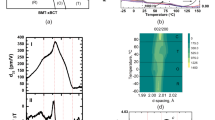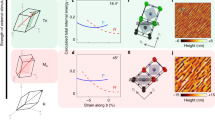Abstract
A centrosymmetric stress cannot induce a polar response in centric materials; piezoelectricity is, for example, possible only in non-centrosymmetric structures. An exception is metamaterials with shape asymmetry, which may be polarized by stress even when the material is centric. In this case the mechanism is flexoelectricity, which relates polarization to a strain gradient. The flexoelectric response scales inversely with size, thus a large effect is expected in nanoscale materials. Recent experiments in polycrystalline, centrosymmetric perovskites (for example, (Ba, Sr)TiO3) have indicated values of flexoelectric coefficients that are orders of magnitude higher than theoretically predicted, promising practical applications based on bulk materials. We show that materials with unexpectedly large flexoelectric response exhibit breaking of the macroscopic centric symmetry through inhomogeneity induced by the high-temperature processing. The emerging electro-mechanical coupling is significant and may help to resolve the controversy surrounding the large apparent flexoelectric coefficients in this class of materials.
This is a preview of subscription content, access via your institution
Access options
Subscribe to this journal
Receive 12 print issues and online access
$259.00 per year
only $21.58 per issue
Buy this article
- Purchase on Springer Link
- Instant access to full article PDF
Prices may be subject to local taxes which are calculated during checkout






Similar content being viewed by others
References
Frenkel, A. et al. Origin of polarity in amorphous SrTiO3 . Phys. Rev. Lett. 99, 215502 (2007).
Scott, J. F. Lattice perturbations in CaWO4 and CaMoO4 . J. Chem. Phys. 48, 874–876 (1968).
Fox, G. R., Yamamoto, J. K., Miller, D. V., Cross, L. E. & Kurtz, S. K. Thermal hysteresis of optical second harmonic in paralelectric BaTiO3 . Mater. Lett. 9, 284–288 (1990).
Wieczorek, K. et al. Electrostrictive and piezoelectric effect in BaTiO3 and PbZrO3 . Ferroelectrics 336, 61–67 (2006).
Beige, H., Birkholz, C., Ciesla, E. & Schmidt, G. Elastic and electromechanical properties of some crystals near structural phase transitions. Phys. Status Solidi B 76, K47–K50 (1976).
Lines, M. E. & Glass, A. M. Principles and Applications of Ferroelectrics and Related Materials (Clarendon, 1979).
Kleemann, W., Schafer, F. J. & Fontana, M. D. Crystal optical studies of spontaneous and precursor polarization in KNbO3 . Phys. Rev. B 30, 1148–1154 (1984).
Aktas, O., Carpenter, M. A. & Salje, E. K. H. Polar precursor ordering in BaTiO3 detected by resonant piezoelectric spectroscopy. Appl. Phys. Lett. 103, 142902 (2013).
Morozovska, A. N., Eliseev, E. A., Kalinin, S. V., Qing Chen, L. & Gopalan, V. Surface polar states and pyroelectricity in ferroelastics induced by flexo-roto field. Appl. Phys. Lett. 100, 142902 (2012).
Burns, G. & Dacol, F. Crystalline ferroelectrics with glassy polarization behavior. Phys. Rev. B 28, 2527–2530 (1983).
Bussmann-Holder, A., Beige, H. & Völkel, G. Precursor effects, broken local symmetry, and coexistence of order–disorder and displacive dynamics in perovskite ferroelectrics. Phys. Rev. B 79, 184111 (2009).
Kuroiwa, Y. et al. High-energy SR powder diffraction evidence of multisite disorder of Pb atom in cubic phase of PbZr1−xTixO3 . Jpn. J. Appl. Phys. 44, 7151–7155 (2005).
Prosandeev, S., Wang, D. & Bellaiche, L. Properties of epitaxial films made of relaxor ferroelectrics. Phys. Rev. Lett. 111, 247602 (2013).
Bursian, E. V. & Zaikovski, O. I. Changes in the curvaure of a ferroelectric film due to polarization. Sov. Phys.-Solid State 10, 1121–1124 (1968).
Luo, Y. et al. Upward ferroelectric self-poling in (001) oriented PbZr0.2Ti0.8O3 epitaxial films with compressive strain. AIP Adv. 3, 122101 (2013).
Fousek, J., Cross, L. E. & Litvin, D. B. Possible piezoelectric composites based on the flexoelectric effect. Mater. Lett. 39, 287–291 (1999).
Cross, L. E. Flexoelectric effects: Charge separation in insulating solids subjected to elastic strain gradients. J. Mater. Sci. 41, 53–63 (2006).
Tagantsev, A. K. Piezoelectricity and flexoelectricity in crystalline dielectrics. Phys. Rev. B 34, 5883–5889 (1986).
Majdoub, M. S., Sharma, P. & Cagin, T. Enhanced size-dependent piezoelectricity and elasticity in nanostructures due to the flexoelectric effect. Phys. Rev. B 77, 125424 (2008).
Fu, J. Y., Zhu, W. Y., Li, N., Smith, N. B. & Cross, L. E. Gradient scaling phenomenon in microsize flexoelectric piezoelectric composites. Appl. Phys. Lett. 91, 182910 (2007).
Lu, H. et al. Mechanical writing of ferroelectric polarization. Science 336, 59–61 (2012).
Catalan, G. et al. Flexoelectric rotation of polarization in ferroelectric thin films. Nature Mater. 10, 963–967 (2011).
Borisevich, A. Y. et al. Atomic-scale evolution of modulated phases at the ferroelectric-antiferroelectric morphotropic phase boundary controlled by flexoelectric interaction. Nature Commun. 3, 775 (2012).
Lakes, R. The role of gradient effects in the piezoelectricity of bone. IEEE Trans. Biomed. Eng. 27, 282–283 (1980).
Ma, W. H. & Cross, L. E. Flexoelectric effect in ceramic lead zirconate titanate. Appl. Phys. Lett. 86, 072905 (2005).
Chu, B., Zhu, W., Li, N. & Cross, L. E. Flexure mode flexoelectric piezoelectric composites. J. Appl. Phys. 106, 104109 (2009).
Ponomareva, I., Tagantsev, A. K. & Bellaiche, L. Finite-temperature flexoelectricity in ferroelectric thin films from first principles. Phys. Rev. B 85, 104101 (2012).
Hong, J. & Vanderbilt, D. First-principles theory and calculation of flexoelectricity. Phys. Rev. B 88, 174107 (2013).
Yudin, P. V., Ahluwalia, R. & Tagantsev, A. K. Upper bounds for flexoelectric coefficients in ferroelectrics. Appl. Phys. Lett. 104, 082913 (2014).
Zhou, L., Vilarinho, P. M. & Baptista, J. L. Dependence of the structural and dielectric properties of Ba1−xSrxTiO3 ceramic solid solutions on raw material processing. J. Eur. Ceram. Soc. 19, 2015–2020 (1999).
Ma, W. H. & Cross, L. E. Flexoelectric polarization of barium strontium titanate in the paraelectric state. Appl. Phys. Lett. 81, 3440–3442 (2002).
Zubko, P., Catalan, G., Buckley, A., Welche, R. L. & Scott, J. F. Strain-gradient-induced polarization in SrTiO3 single crystals. Phys. Rev. Lett. 99, 167601 (2007).
Williamson, G. K. & Hall, W. H. X-ray line broadening from filed aluminium and wolfram. Acta Metall. 1, 22–31 (1953).
Narvaez, J. & Catalan, G. Origin of the enhanced flexoelectricity of relaxor ferroelectrics. Appl. Phys. Lett. 104, 162903 (2014).
Chynoweth, A. G. Dynamic method for measuring the pyroelectric effect with special refernce to barium titanate. J. Appl. Phys. 27, 78–84 (1956).
Newnham, R. E. Properties of Materials: Anisotropy, Symmetry, Structure (Oxford Univ. Press, 2005).
Jaffe, B., Cook, W. R. & Jaffe, H. Piezoelectric Ceramics (Academic, 1971).
Dec, J. et al. Probing polar nanoregions in Sr0.61Ba0.39Nb2O6 via second-harmonic dielectric response. Phys. Rev. B 68, 092105 (2003).
Van Turnhout, J. Thermally Stimulated Discharge of Polymer Electrets: A Study on Nonisothermal Dielectric Relaxation Phenomena (Elsevier, 1975).
Lau, W. S., Chong, T. C., Tan, L. S., Goo, C. H. & Kian, S. G. The characterization of traps in semi-insulating gallium arsenide buffer layers grown at low temperature by molecular beam epitaxy with an improved zero-bias thermally stimurated current technique. Jpn. J. Appl. Phys. 30, L1843–L1846 (1991).
Roth, M., Mojaev, E., Dul’kin, E., Gemeiner, P. & Dkhil, B. Phase transition at a nanometer scale detected by acoustic emission within the cubic phase Pb(Zn1/3Nb2/3)O3-xPbTiO3 relaxor ferroelectrics. Phys. Rev. Lett. 98, 265701 (2007).
Cao, Y., Shen, J., Randall, C. A. & Chen, L. Q. Phase-field modeling of switchable diode-like current–voltage characteristics in ferroelectric BaTiO3 . Appl. Phys. Lett. 104, 182905 (2014).
Liu, W. & Randall, C. A. Thermally stimulated relaxation in Fe-doped SrTiO3 Systems: II. Degradation of SrTiO3 dielectrics. J. Am. Ceram. Soc. 91, 3251–3257 (2008).
Aschauer, U., Pfenninger, R., Selbach, S. M., Grande, T. & Spaldin, N. A. Strain-controlled oxygen vacancy formation and ordering in CaMnO3 . Phys. Rev. B 88, 054111 (2013).
Adler, S. B. Chemical expansivity of electrochemical ceramics. J. Am. Ceram. Soc. 84, 2117–2119 (2001).
Erhart, P. & Albe, K. Thermodynamics of mono- and di-vacancies in barium titanate. J. Appl. Phys. 102, 084111 (2007).
Lewis, G. V. & Catlow, C. R. A. Defect studies of doped and undoped barium titanate using computer simulation techniques. J. Phys. Chem. Solids 47, 89–97 (1986).
Levin, I., Krayzman, V. & Woicik, J. C. Local structure in perovskite (Ba, Sr)TiO3: Reverse Monte Carlo refinements from multiple measurement techniques. Phys. Rev. B 89, 024106 (2014).
Lenel, F. V., Hausner, H. H., Roman, O. V. & Ansell, G. S. The influence of gravity in sintering. Powder Metall. Met. Ceram. 2, 379–384 (1963).
Acknowledgements
This work was supported by the Swiss National Science Foundation through NRP62 ‘Smart materials’ (Project No. 406240 -126091). The authors acknowledge the use of the Analytical Instrumentation Facility (AIF) at North Carolina State University, which is supported by the State of North Carolina and the National Science Foundation.
Author information
Authors and Affiliations
Contributions
A.B. prepared all materials and performed most of the experiments. D.D. conceived the idea of testing the symmetry breaking and its effect on the apparent flexoelectric response, and performed some of the experiments. A.B. and D.D. analysed and interpreted the electrical data. C.M.F. performed XRD measurements and analysed the data under the supervision of J.L.J. D.D. wrote the article and all authors contributed and commented on the text.
Corresponding author
Ethics declarations
Competing interests
The authors declare no competing financial interests.
Supplementary information
Supplementary Information
Supplementary Information (PDF 1477 kb)
Rights and permissions
About this article
Cite this article
Biancoli, A., Fancher, C., Jones, J. et al. Breaking of macroscopic centric symmetry in paraelectric phases of ferroelectric materials and implications for flexoelectricity. Nature Mater 14, 224–229 (2015). https://doi.org/10.1038/nmat4139
Received:
Accepted:
Published:
Issue Date:
DOI: https://doi.org/10.1038/nmat4139
This article is cited by
-
Uncertainty quantification of mechanical property of piezoelectric materials based on isogeometric stochastic FEM with generalized nth-order perturbation
Engineering with Computers (2024)
-
Enhancement of thermal-electrical like response by flexoelectric effect in sodium bismuth titanate bilayer ceramics with compositional inhomogeneity
Journal of the Korean Ceramic Society (2024)
-
Broadband Low-Frequency Acoustic Energy Harvesting Amplified by Sonic Crystal Metamaterial with Double Defects
Journal of Vibration Engineering & Technologies (2024)
-
Bridging the gap between density functional theory and quantum materials
Nature Computational Science (2022)
-
Lead-free relaxor-ferroelectric thin films for energy harvesting from low-grade waste-heat
Scientific Reports (2021)



